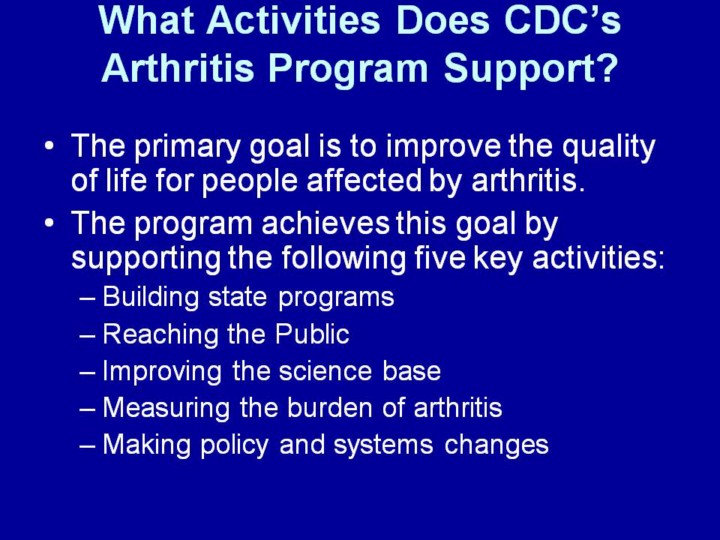| front |1 |2 |3 |4 |5 |6 |7 |8 |9 |10 |11 |12 |13 |14 |15 |16 |17 |18 |19 |20 |21 |22 |23 |24 |25 |26 |27 |28 |29 |review |
 |
What Activities Does CDC’s Arthritis Program Support? The primary goal of CDC’s arthritis program is to improve the quality of life for people affected by arthritis. The program achieves this goal by supporting the following five key activities: 1. Building state programs. Over the past 5 years, state health departments have successfully used CDC funding to build capacity in their arthritis programs. These efforts include creating new partnerships, increasing public awareness, improving their ability to monitor the burden of arthritis, and delivering evidence-based interventions. In Spring 2007, CDC convened national experts to guide future program directions. These experts made several important recommendations, including the following:
Fund state programs at higher levels to address arthritis
through broader public health efforts (previous funding averaged $160,000
per state in 36 states).
Work to expand evidence-based interventions. Develop new
interventions and expand existing ones to provide services to more people
with arthritis.
Create and expand innovative partnerships at local, state,
and national levels. Consider national campaigns, marketing and health communications, and policy interventions. These recommendations will drive future state program activities, building on the lessons learned by the 36 states funded during 2003–2008. For the next cooperative agreement period, 2008–2011, CDC has funded 12 states, with average funding of about $500,000. This funding level is on par with other major chronic disease programs. CDC also is working with the National Association of Chronic Disease Directors (NACDD) to support efforts in other states to integrate arthritis interventions into existing chronic disease programs. 2. Reaching the Public. CDC, working with state health departments and Arthritis Foundation chapters, developed a communications campaign that promotes physical activity among people with arthritis who are aged 45–70 and of low socioeconomic status. The “Physical Activity. The Arthritis Pain Reliever.” campaign has been used by state health departments and several Arthritis Foundation chapters. A similar campaign for Hispanic audiences is now available, and a new physical activity campaign is being developed. 3. Improving the science base. CDC supports research to learn more about arthritis and effective management strategies. For example,
Systemic lupus erythematosus is a serious autoimmune
inflammatory disease that affects multiple systems in the body. It can be
difficult to diagnose, and prevalence estimates vary widely. CDC is
supporting researchers at the University of Michigan and Emory University,
through the Michigan and Georgia state health departments, to establish
registries to produce more reliable estimates of lupus.
Physical activity is crucial for arthritis self-management.
CDC is evaluating existing physical activity programs and developing new
ones for people who have arthritis. Walking is one of the most feasible
forms of physical activity for most people, since it is low impact, requires
no special equipment or facilities, and can be done anywhere and at anytime.
CDC is supporting researchers at the University of North Carolina at Chapel
Hill to evaluate group-based and self-directed walking programs among a
culturally diverse sample of adults with arthritis. Self-management education programs have been proven to reduce pain and costs, yet not all people with arthritis are able to participate. CDC is supporting researchers at the University of North Carolina at Chapel Hill and Stanford University to develop and evaluate programs that can be delivered by mail or online, making self-management education more widely available. 4. Measuring the burden of arthritis. At the national level, CDC uses surveys to define the burden of arthritis, monitor trends, and assess how arthritis affects quality of life. At the state level, CDC and states use the Behavioral Risk Factor Surveillance System (BRFSS) to collect arthritis data. In addition, the Arthritis Conditions Health Effects Survey (ACHES), a national telephone survey completed in 2006 among adults aged 45 years or older who reported arthritis, collected information about the effects of arthritis on everyday life. 5. Making policy and systems changes. CDC’s epidemiology and surveillance activities collect data useful to policy decision makers. Examples include cost estimates and data on arthritis-attributable work limitations at state and national levels. CDC researchers also collect and analyze data on the occurrence of arthritis among people with diabetes and heart disease, as well as related risk factors. Future CDC and state efforts will include attention to these risk factors as starting points for policy changes that support public health approaches to addressing arthritis. In partnership with the Arthritis Foundation, CDC is convening science, program, and policy leaders to develop a national public health agenda for addressing osteoarthritis, the most common type of arthritis and a frequent cause of disability. The agenda will develop strategies for making osteoarthritis a major public health issue in the next 5 years. |